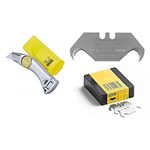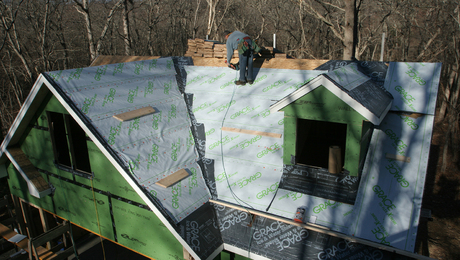
I live in the rainy Pacific Northwest, and I recently noticed what looks like mold on the cedar boards of my cathedral ceiling. It appears to be between a couple of rafters. Although there is good venting at the eaves, there is no venting at the ridge. What’s the probable cause of this apparent mold, and what’s a possible solution?
—ED via email
Martin Holladay, editor of Green Building Advisor, responds: Mold growth occurs under conditions of high humidity. In your climate, one possibility is that your indoor relative humidity is too high; this is especially likely if your house doesn’t have air-conditioning. Ideally, your home’s HVAC equipment will keep the indoor relative humidity below 40% during the winter and below 60% during the summer. If you don’t know your home’s indoor relative humidity, buy a few hygrometers and begin monitoring. If your indoor relative humidity is high, you need a dehumidifier or an air conditioner.
It’s also possible—though, in my experience, unlikely—that your ceiling boards are damp because of a roof leak. Roof leaks usually leave stains or reveal themselves via drips, and you don’t mention any stains on your ceiling boards.
Finally, there’s the lack of a ridge vent. Whether or not your roof assembly needs a ridge vent depends on the type of insulation installed. Unvented roof assemblies should have exterior rigid foam or spray foam between the rafters; if you have one of these types of insulation, no ridge vent is needed.
If your roof assembly is insulated with fiberglass batts, mineral wool, or cellulose, you need a ventilation channel between the top of the insulation layer and the underside of the roof sheathing. You also need a ridge vent. If you have this type of insulation, it isn’t very hard to install a ridge vent (assuming you have a gable roof).
Verifying whether or not your roof has a ventilation gap between the top of the insulation and the underside of the roof sheathing can be tricky, and probably isn’t necessary if all you care about is fixing your mold problem. You may be able to tell what’s going on by removing the soffit and looking upward with a strong light. If you decide to open up the ridge to install a ridge vent, you’ll have a chance to inspect the rafter bays from the top. If one of these inspections reveals that your insulation is tight to the roof sheathing, it’s going to be tough to create a ventilation channel under your roof sheathing. In that case, the best way to improve the performance of your roof assembly might be to install rigid foam above the roof sheathing, followed by a second layer of rigid foam with the seams staggered relative to the first layer, and to finish the job with an additional layer of sheathing and new roofing.
While the lack of a ridge vent could conceivably be causing mold on your ceiling boards, that’s not the usual symptom of poor ventilation. The usual symptom in such a case would be a dripping ceiling during cold weather (or during a warm spell immediately after a cold spell).
More about moisture and mold problems:
- Understanding Common Moisture Problems
- Video: Using a Moisture Meter
- Waterproofing a Basement From the Inside
Fine Homebuilding Recommended Products
Fine Homebuilding receives a commission for items purchased through links on this site, including Amazon Associates and other affiliate advertising programs.

Hook Blade Roofing Knife

Roofing Gun

Flashing Boot






























View Comments
I would install a ceiling fan or 2 to move the trapped warm humid air .
Wood requires more detailed care, the mold is the first enemy. I used a humidifier of this model here Oransi Finn Air Purifier. You can look at different options here https://wisepick.org/best-air-purifier-for-mold, there is a detailed description that will help with a more accurate choice. Mold should start to disappear in the course of the week. I had a similar problem in the bath due to the high concentration of moisture, I solved it by calibrating the extractor and air humidifier.
Mold doesn’t just disappear? That’s the first issue.. what is it? There could be 15 feet of mold-roots that the human eye can’t see…test first!
I am also face same problem. But if some tips follow mold problem can overcome easily. Dry the area thoroughly, moisture is mold’s best friend. When done scrubbing the area, there should be no visible mold or moldy smell. Make sure the area is completely clean and dry before painting or caulking
Wear a mask, HEPA vac and then wipe down with hydrogen peroxide and leave on for like 20 minutes or so, make sure you use an rented air scrubber and tape off everything that you don’t want to get infected…
I was facing same problem in my new home when i shifted in Colorado and in addition the walls nearest from bathroom were also infected with mold then i called a cleaning company in Steamboat Spring for mold remediation ,Service Master Colorado ServiceMaster Cleaning & Restoration By SteamExpress.This company is Best for mold remediation in Colorado,US.
Website : http://servicemastercolorado.com/damage-cleanup/mold-mitigation/
Yes, use a mold remediation company, don’t do it yourself….my thought here and I’ve run into this multiple time in my clients homes, 1. Mold test first, find out what strain if any the mold is?
2. Get a moisture meter up there and get readings?
3. Ventilate ; someone mentioned a fan, if added reverse it in the winter…
4. Most if not all cathedral ceilings are insulated wrong, gaps and cracks no taping, trapped moisture, convection, conduction, on and on and on?